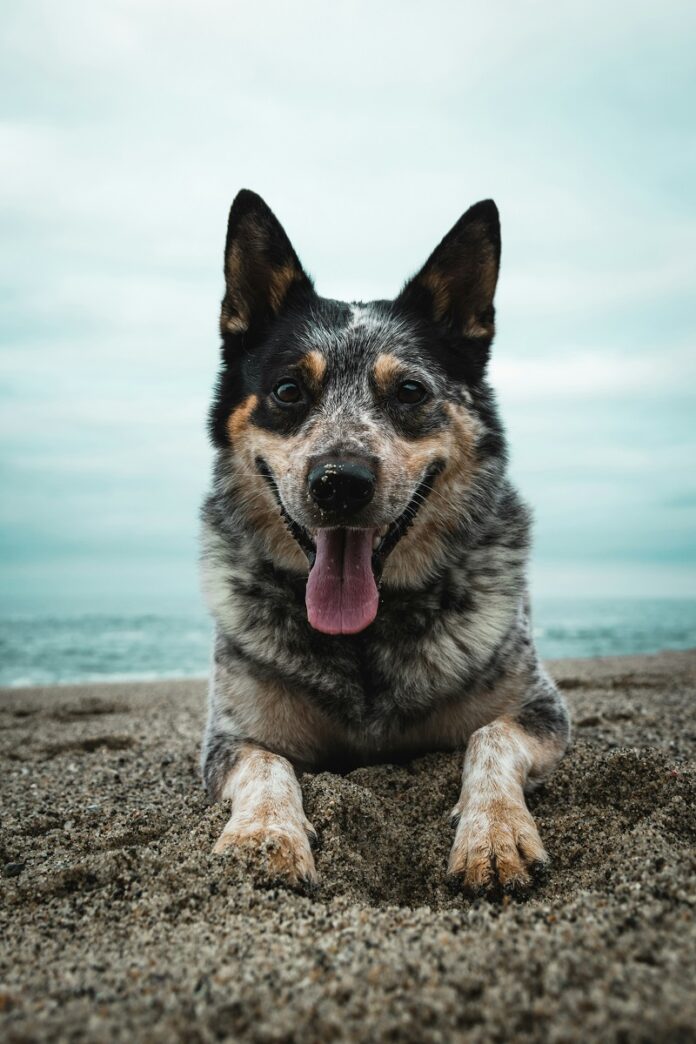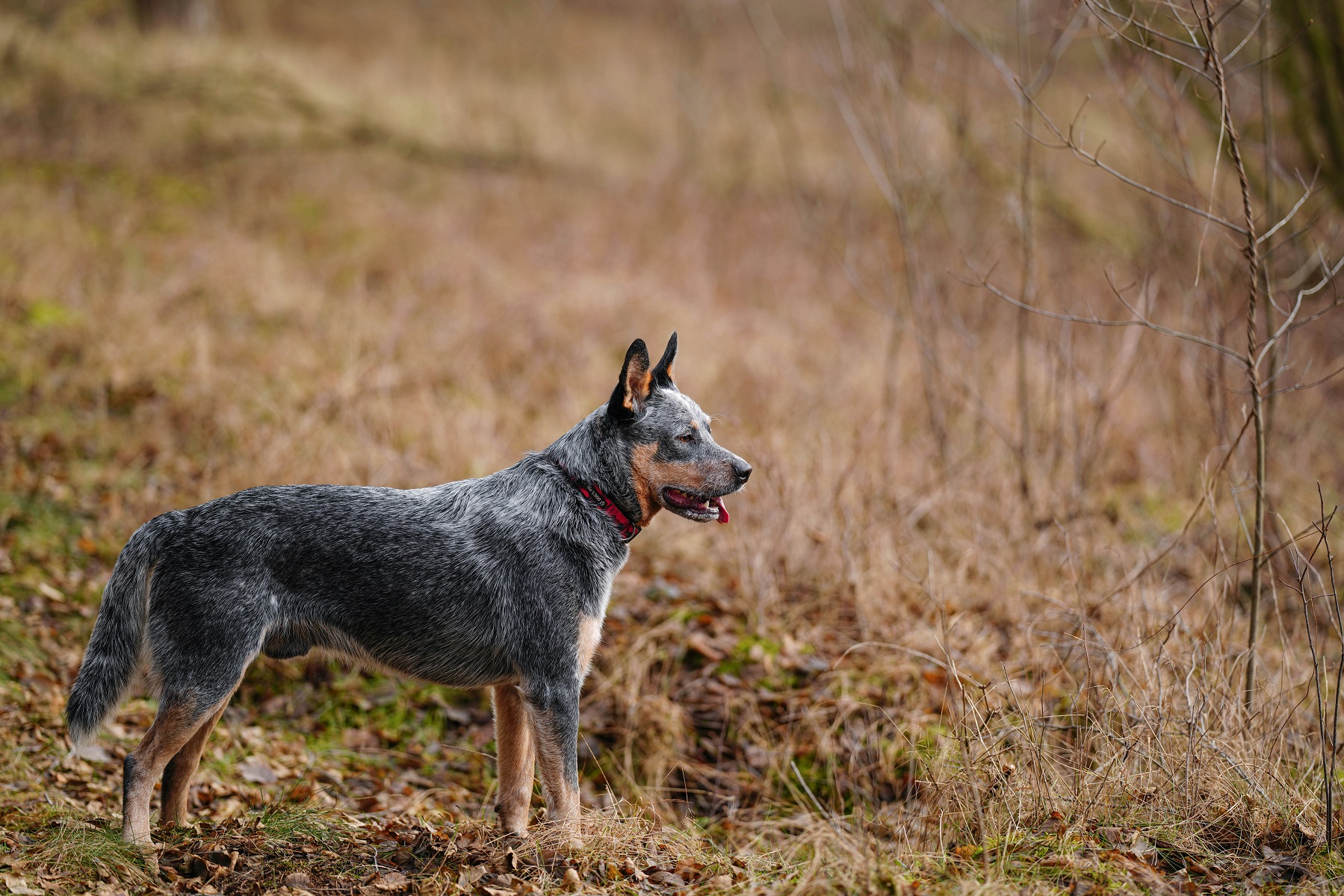Summary: The Australian Cattle Dog, also known as the Blue Heeler or Queensland Heeler, is a highly intelligent, energetic, and hardworking breed developed in Australia for herding cattle. Known for their loyalty, agility, and endurance, these dogs excel in active households and on farms. With a short, weather-resistant coat and a strong protective instinct, Australian Cattle Dogs are great companions for experienced owners who can provide firm training, mental stimulation, and plenty of exercise. Their herding instincts and loyalty make them excellent working dogs and devoted family protectors.
Australian Cattle Dog is one of the hardest-working and intelligent dog breeds in the world. Bred to herd cattle across the vast and rugged landscapes of Australia, these dogs are not just physically strong but mentally sharp and incredibly loyal. Also known as the Blue Heeler or Queensland Heeler, this breed has become a favorite among farmers, ranchers, and active families who can match its energy and enthusiasm.
If you are considering adding an Australian Cattle Dog to your home, or are just interested in learning more about this dynamic breed, this comprehensive guide will walk you through its origin, personality, physical traits, care requirements, and more.
Origin and History
The story of the Australian Cattle Dog begins in the 1800s, when European settlers in Australia needed a dog that could withstand the harsh climate and cover long distances while herding cattle. The native English herding breeds struggled with the tough conditions, prompting breeders to experiment by crossing Smooth Collies, Dalmatians, and even Dingoes, the native wild dogs of Australia.
The result was a rugged, weather-resistant, and highly trainable breed capable of controlling unruly cattle with ease. The dog’s unique method of nipping at the heels of livestock earned it the nickname “Heeler.” Over time, two main color variants developed — the Blue Heeler and the Red Heeler, both recognized today under the same breed standard.
Physical Characteristics
Australian Cattle Dogs are compact, muscular, and sturdy animals built for endurance and agility. Their body structure is symmetrical and strong, allowing them to move quickly and efficiently over varied terrain.
Most Australian Cattle Dogs stand between 17 to 20 inches (43 to 51 cm) tall and weigh around 35 to 50 pounds (16 to 23 kg). They have a double-layered coat that’s dense, weatherproof, and short. This breed is known for its striking coat patterns: the blue speckled or mottled look for Blue Heelers, and the red speckled look for Red Heelers. Puppies are born white and develop their adult colors as they grow older.
Their head is broad and slightly curved, with pricked ears and a strong jaw. The eyes are oval-shaped and typically dark, with a keen and intelligent expression.
Temperament
Australian Cattle Dogs are known for their intelligence, loyalty, and independent thinking. These dogs are highly alert and protective, often forming intense bonds with one or two people in the household. While they are affectionate with their families, they can be wary of strangers and unfamiliar animals, making them excellent watchdogs.
Because of their working background, Australian Cattle Dogs are naturally energetic and require a sense of purpose. They love having jobs to do, whether it’s herding livestock, playing fetch, or participating in canine sports like agility and obedience. Without enough physical and mental stimulation, they can become bored, which may lead to destructive behaviors like digging, chewing, or excessive barking.
Though they are not aggressive by nature, their herding instincts may lead them to chase or nip at the heels of children or other pets. Early socialization and consistent training are crucial to ensure they learn appropriate behavior in various situations.
Australian Cattle Dog Training
Training an Australian Cattle Dog can be highly rewarding if approached correctly. These dogs are fast learners and eager to please, but they also have an independent streak that requires firm, consistent leadership.
Positive reinforcement techniques work best. Reward-based training using treats, praise, or toys will motivate your dog and help build trust. It’s important to keep training sessions short, varied, and engaging, as repetition can quickly bore this intelligent breed.
Early socialization is key. Introduce your puppy to a variety of people, pets, environments, and experiences during their first few months. This helps curb potential aggression or wariness and creates a well-adjusted adult dog.
Additionally, providing your dog with daily “jobs” like obedience tasks, fetch games, or even learning new tricks can fulfill their need for work and reduce behavioral issues.
Exercise and Activity Requirements
Australian Cattle Dogs are among the most active dog breeds and require at least 1 to 2 hours of vigorous exercise each day. They are not suited for a sedentary lifestyle or owners who are away for long hours.
Their high energy levels mean that daily walks alone are not enough. Activities like hiking, running, agility training, frisbee, and obedience competitions are ideal. These dogs also enjoy working on farms or ranches where they can use their herding instincts.
If kept in an urban or suburban environment, a secure backyard is a must, as these dogs can become escape artists if bored. Mental stimulation is just as important as physical activity — puzzle toys, training exercises, and interactive games can help keep their minds sharp.
Health and Lifespan
The Australian Cattle Dog is a generally healthy and robust breed with a lifespan of 12 to 16 years. In fact, one Australian Cattle Dog named Bluey holds the Guinness World Record for the oldest dog ever, living to 29 years and 5 months.
However, like all breeds, they are prone to certain health issues. Common concerns include:
Progressive Retinal Atrophy (PRA) is a degenerative eye condition that can lead to blindness.
Hip and Elbow Dysplasia are joint problems that can cause pain or mobility issues.
Deafness congenital deafness is more common in puppies with a lot of white in their coat.
Luxating Patella is a knee issue that can affect movement.
To ensure a healthy life, it’s essential to purchase your dog from a reputable breeder who tests for genetic conditions. Routine veterinary check-ups, vaccinations, parasite prevention, and a healthy diet will also go a long way in keeping your Cattle Dog in top condition.
Grooming
Despite their rugged outdoor nature, Australian Cattle Dogs are relatively easy to groom. Their short double coat is self-cleaning and repels dirt, though they do shed moderately throughout the year and heavily during seasonal changes.
Weekly brushing with a slicker brush or rubber grooming mitt helps remove dead hair and keeps their coat looking its best. During shedding season, brushing more frequently can help manage loose fur. Baths are only needed occasionally, unless the dog gets particularly dirty.
Additionally, their nails should be trimmed every 3–4 weeks, ears cleaned regularly, and teeth brushed a few times a week to prevent dental issues.
Living Environment and Suitability
Australian Cattle Dog is best suited for owners who lead an active lifestyle and can dedicate time to training, playing, and exercising with their dog. Australian Cattle Dogs do best in homes with a large yard, on a farm, or with access to wide open spaces where they can run freely.
They are not ideal for apartment living unless their physical and mental exercise needs are fully met. This breed thrives in environments where it has a job to do and space to explore.
Families with older children, couples, or individuals who enjoy outdoor adventures are often the best match for an Australian Cattle Dog. However, due to their herding instinct, they may try to herd small children or other pets unless properly trained and socialized.
Interesting Facts About Australian Cattle Dogs
Australian Cattle Dogs are considered one of the top 10 most intelligent dog breeds.
Their lineage includes Dingo DNA, which contributes to their toughness and adaptability.
They often develop strong attachments to a single person and may follow them everywhere earning the nickname “Velcro Dog.”
The famous dog “Bluey” was a real-life Cattle Dog who worked with cattle for nearly 20 years and lived longer than any other known dog.
The American Bully A Comprehensive Guide to Understanding and Caring for This Unique Breed
Frequently Asked Questions
What is an Australian Cattle Dog?
The Australian Cattle Dog is a herding breed developed in Australia, known for its intelligence, stamina, and strong work ethic.
Are Australian Cattle Dogs good family pets?
They can be excellent family pets for active households, but they need consistent training and socialization from an early age.
Do Australian Cattle Dogs shed?
Yes, they have a short double coat that sheds year-round, with heavier shedding during seasonal changes.
How much exercise does an Australian Cattle Dog need?
They need at least 1 to 2 hours of vigorous exercise daily, including walks, playtime, and mental challenges.
Are Australian Cattle Dogs aggressive?
They are not naturally aggressive but can be protective and territorial. Proper training and socialization are essential.
Can Australian Cattle Dogs live in apartments?
They can adapt to apartment living if their high physical and mental exercise needs are met daily.
How long do Australian Cattle Dogs live?
The average lifespan of an Australian Cattle Dog is 12 to 16 years with proper care.
Do Australian Cattle Dogs bark a lot?
They are generally not excessive barkers, but they will alert owners to unusual activity or strangers.
What are common health issues in Australian Cattle Dogs?
Common issues include hip dysplasia, deafness, and progressive retinal atrophy (PRA).
Are Australian Cattle Dogs easy to train?
Yes, they are highly intelligent and respond well to consistent, positive training methods, but they require an experienced handler.


